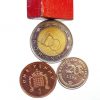Why Are British Coins Magnetic?
If you’ve ever traveled to the UK, you may have noticed some differences in the currency. Obviously, it looks different and it’s called something else (what we call cents, the British call pence or simply “p”). But there are more contrasts at work. British coins are magnetic while American coins aren’t. If you’re like us here at Apex, this is certainly an interesting fact.
To begin, let’s examine what U.S. coins are made out of and rule out why they’re not magnetic. You might think pennies are simply copper and nickels are, well, nickel, but that’s not the case, at least not anymore. Pennies and nickels haven’t been anywhere close to pure metals in quite some time. In fact, most coins are a combination of both copper and nickel. Here’s a quick breakdown:
- Quarter--91.68% Copper, 8.33% Nickel
- Dime--91.68% Copper, 8.33% Nickel
- Nickel--75% Copper, 25% Nickel
- Penny--97.5% Zinc, 2.5% Copper

